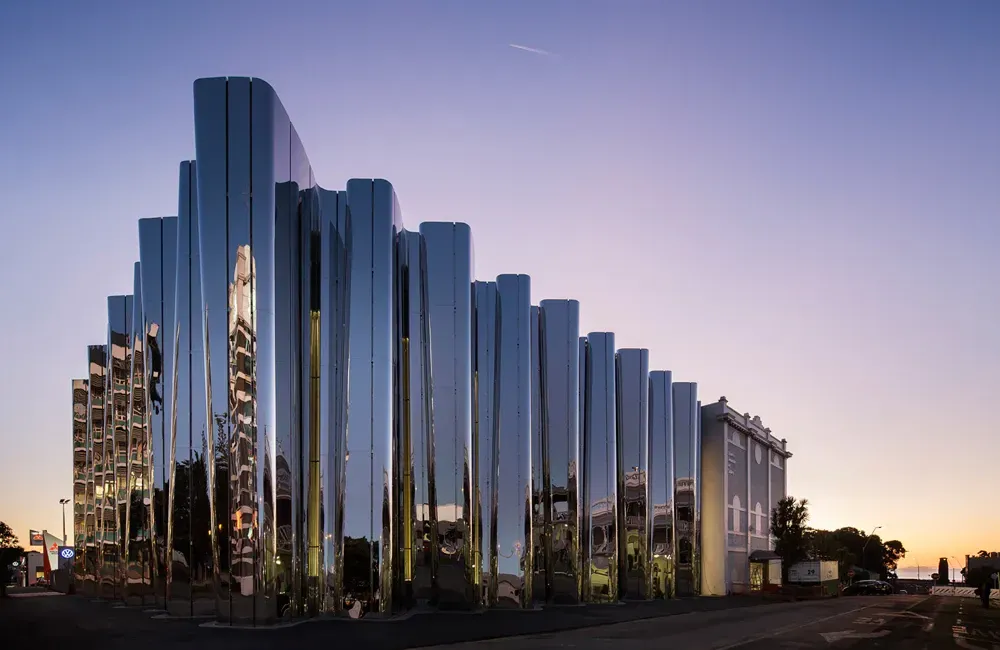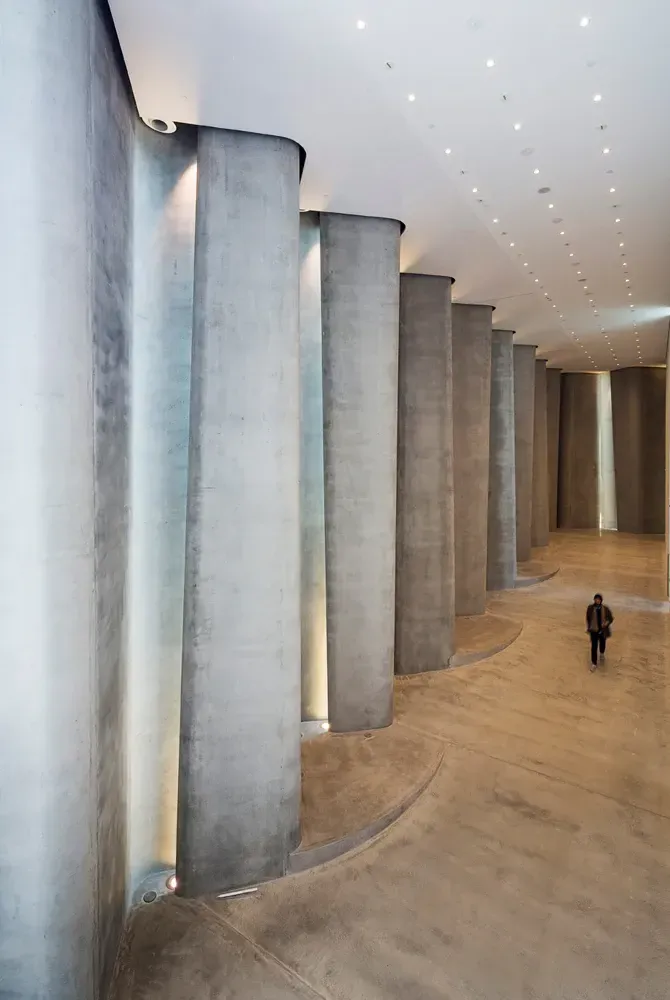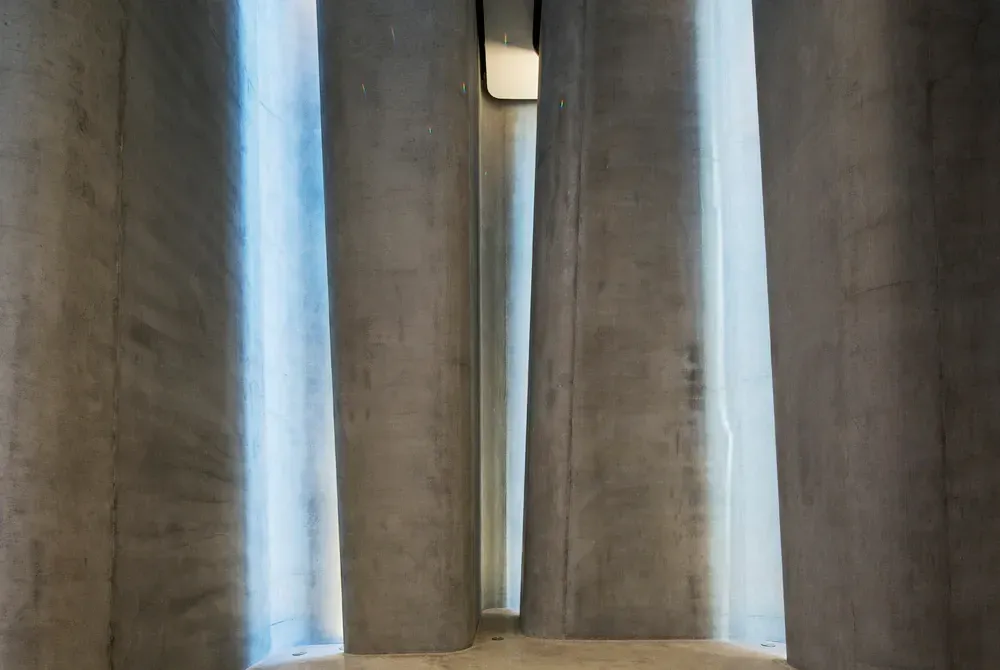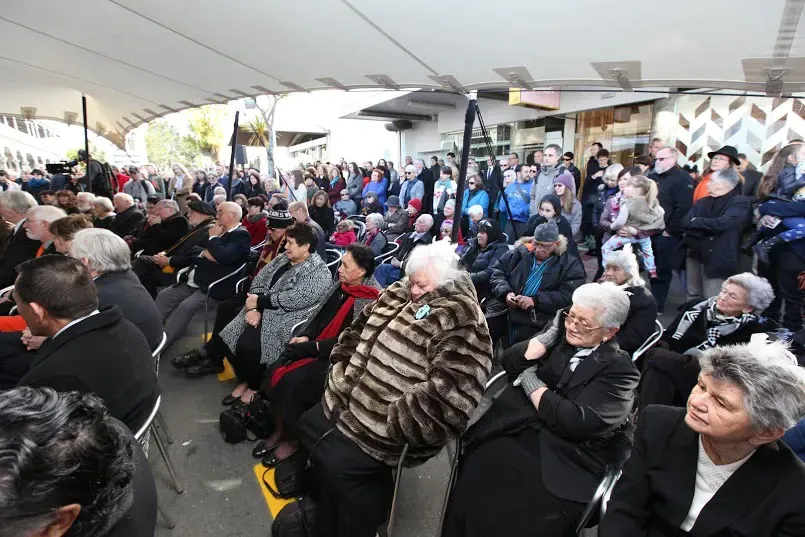Len Lye Centre opens
Written by
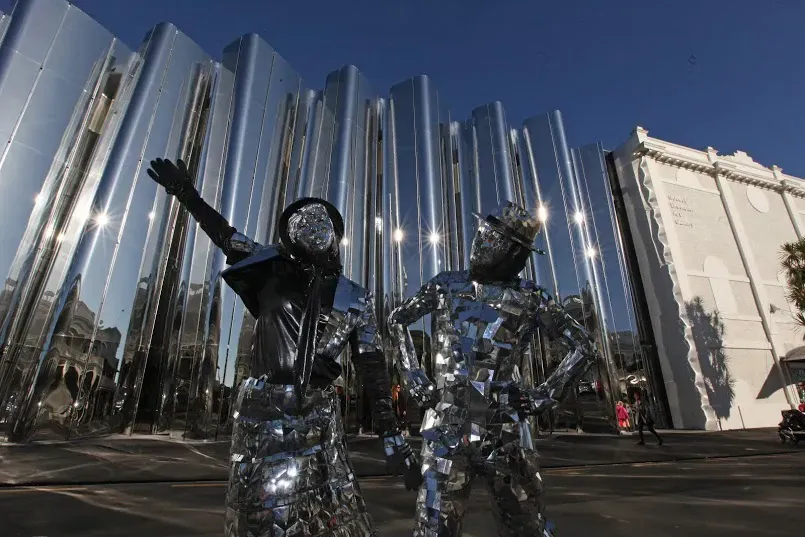
The Govett-Brewster Art Gallery doors have re-opened with a new addition dedicated to the pioneering filmmaker and kinetic sculptor Len Lye.
The opening on 25 July in New Plymouth is the culmination of more than three decades’ commitment to realising a permanent home for Lye’s work, a significant collection and archive of more than 18,000 items.
The Len Lye Centre, designed by New Zealand’s Patterson Associates, is the repository of the works, archive and spirit of Len Lye (1901–1980).
Simon Rees, Govett-Brewster Art Gallery Director, says “the centre’s expansive exhibition spaces, research archive, learning centre, and 62-seat cinema provides the Govett-Brewster the means to truly research, exhibit and disseminate the unique work and vision of Len Lye”.
Born in Christchurch, New Zealand in 1901, Lye spent most of his career as an artist in London and New York where his work was displayed in some of the most influential exhibitions of their time, such as the London International Surrealist Exhibition curated by Herbert Read in 1936, and Directions in Kinetic Sculpture at the Berkeley Art Museum in 1966.
Today his sculptures are held in the collections of the world’s most prestigious institutions of modern art including the collections of several major art museums, such as the Whitney Museum of American Art in New York and the Art Institute of Chicago. Lye’s film work is included in the New Zealand film archive, the British Film Institute and the Museum of Modern Art (MoMA), New York.
Lye exhibited at the Govett-Brewster in 1977 and falling in love with the energy and landscape of New Plymouth, he chose the contemporary art museum to be the home of Len Lye. Just months before his death in 1980, Lye established the Len Lye Foundation to continue his artistic vision, gifting his entire collection and archive to be cared for by the Govett-Brewster.
Len Lye Curator Paul Brobbel says Len Lye fused the European avant-garde with the rhythms of his South Pacific home. Arriving in London in the mid-1920s, he impressed his British peers like Ben Nicholson and Robert Graves with his Brancusi-like sculpture and antipodean flavoured paintings.
“Several years exhibiting with Britain’s Seven and Five Society and befriending a number of the leading artists he exhibited with placed Lye in strong company,” says Brobbel. “Never a card carrying member of any movement or clique, Lye preferred to follow his own path, establishing himself in the 1930s as a leading proponent of experimental film through his development of ‘direct’ animation. His inventive and flamboyant approach to film produced masterpieces such as A Colour Box (1935) and Trade Tattoo (1937), each a thrilling showcase of what the artist could achieve applying images to celluloid without the use of camera,” he says.
A mid-career move to the United States in 1944 connected to a project commissioned by Presidential Candidate Wendell Willkie put Lye into a new scene, the thriving cultural capital of post-war New York. A new wave of film experiments established Lye in the American film underground.
Lye’s film masterpiece Free Radicals (1958) marked Lye as the abstract-expressionist film maker par excellence before he diverted his practice into the realm of kinetic sculpture. Just a year after Jean Tinguely’s historic sculpture Homage to New York (1960) performed at New York’s Museum of Modern Art, Lye’s ‘tangible motion sculpture’ performed at the same venue.
By the mid-1960s, Lye was recognised as one of the most compelling artists working in the field of kinetics with the violent and chilling Trilogy (A Flip and Two Twisters) applauded as a standout work in Peter Selz 1966 exhibition at Berkeley.
Simon Rees, Govett-Brewster Art Gallery Director, says Lye was attracted to the Govett-Brewster because from its opening in 1970 it has forged a reputation for ground breaking exhibition making and producing projects with artists at fulcrum moments in their careers.
“The inaugural exhibition was given over to a 23-year old artist Leon Narbey. Lye’s 1977 exhibition at Govett-Brewster was the first survey of his work.”
“Many works made for these exhibitions, such as Trilogy (A Flip and Two Twisters), are acquired for the Govett-Brewster Collection, which keeps artists connected with the museum for long periods. Many people are aware of the important relationship (spanning three generations) the museum has with New Zealand artists such as Billy Apple, Mladen Bizumic, Fiona Clark, Don Driver, et al., Peter Peryer, and Peter Robinson, and the strong collection of Colin McCahon works. They should also know that it has exhibited work by a range of renowned international artists ahead-of-the-curve such as, Makoto Aida (2004), Candice Breitz (2003), Luke Fowler (2003), Christian Marclay (2001), Maix Mayer (2002), Jonathan Monk (2000), Pae White (2002) and Christopher Williams (2001).”
The addition of the Len Lye Centre enables a new international connectivity, especially through its cinema, and brings the museum into contact with the modern in a productive way, says Rees.
About Govett-Brewster Art Gallery/Len Lye Centre
The Govett-Brewster Art Gallery is New Zealand’s contemporary art museum in the coastal city of New Plymouth, Taranaki on the North Island of Aotearoa New Zealand. Since opening in 1970, the Gallery has dedicated itself to innovative programming, focused collection development and audience engagement. It has earned a strong reputation nationally and internationally for its global vision and special commitment to contemporary art of the Pacific Rim. The Govett-Brewster is also home to the collection and archive of the seminal modernist filmmaker and kinetic sculptor Len Lye (1901–1980).
The Govett-Brewster Art Gallery was founded with a gift to the city of New Plymouth, from one of its greatest ‘Friends’ Monica Brewster (nee Govett). A globetrotter before the age of air travel, Monica Brewster envisaged an art museum for her hometown that would be an international beacon for the art and ideas of the current day – the sort she had become familiar with on her global travels.
The Govett-Brewster continues in the legacy of Monica Brewster by taking on and presenting the most provocative, audacious and confident works of art in the global arts landscape.
The greatly expanded museum re-launched on 25 July 2015 with the addition of the Len Lye Centre. With its curved exterior walls of mirror-like stainless steel, the Govett-Brewster Art Gallery/Len Lye Centre will be the country’s first example of destination architecture linked to contemporary art.
The Govett-Brewster Art Gallery/Len Lye Centre, with its curved exterior walls of mirror-like stainless steel, is the country’s first example of destination architecture linked to contemporary art.
The latest addition to the Govett-Brewster – the Len Lye Centre – is New Zealand’s first institution dedicated to a single artist, the pioneering filmmaker and kinetic sculptor, Len Lye.
Set in the coastal city of New Plymouth, overlooked by the majestic Mount Taranaki on the west coast of New Zealand’s North Island, the centre opened on 25 July, 2015.
In 1964 Len Lye said “Great architecture goes fifty-fifty with great art”
The Len Lye Centre building, adjoining the Govett-Brewster Art Gallery, is an example of innovative thinking in both engineering and architecture.
The architects are Pattersons, one of New Zealand’s most internationally recognised architectural firms.
A temple for art, the space creates a sensory experience of light that Len’s legacy inspires.
The external stainless steel façade echoes the artist’s use of the metal in many of his kinetic sculptures, and the futuristic style of the building acts as a counterfoil to the neighbouring Govett-Brewster’s more traditional lines.
The new Len Lye Centre features Lye’s work in kinetic sculpture, film, painting, drawing, photography, batik and writing, as well as related work by contemporary and historical artists.
It also houses a state-of-the-art 62-seat cinema – a welcoming environment for audiences to experience Len Lye’s films, local and international cinema, arthouse and experimental films, and regular film festival programming.
The Govett-Brewster Art Gallery building in New Plymouth closed in April 2013 for earthquake strengthening, compliance, upgrades and construction of the Len Lye Centre. The Govett-Brewster team has remained active with off-site exhibitions, touring exhibitions, public programmes and work with other cultural organisations.
About Len Lye
A visionary New Zealander, an inspirational artist, a pioneer of film; Len Lye is one of the most important and influential artists to emerge from New Zealand.
Len Lye was an experimental filmmaker, poet, painter, kinetic sculptor and creative visionary ahead of his time. Most of his works were so revolutionary that technology literally had to catch up to him – meaning much of Lye’s work was not realised in his own lifetime.
Lye’s iconic 45-metre kinetic sculpture Wind Wand sways gently on New Plymouth's Coastal Walkway. The Wind Wand that glows red at night, is the first large outdoor sculpture to be built posthumously from his plans and drawings.
In 1977 Lye returned to his homeland to oversee the first New Zealand exhibition of his work at the Govett-Brewster Art Gallery. He called it the “swingiest art gallery of the antipodes”.
Shortly before his death in 1980, Lye and his supporters established the Len Lye Foundation, to which he gifted his entire collection. His collection was gifted on the condition that a suitable and permanent home be created in which his works could be fully realised.
The Len Lye Centre will be New Zealand’s first art museum to be dedicated to a single artist.
The opening exhibitions July 25 – November 29 2015
One of the Len Lye Centre’s opening exhibitions (July 25 – November 29) is Len Lye: Four Fountains in the new Large Works Gallery. An audience favourite, the gentle, swaying Fountain is among the earliest of Lye’s kinetic sculptures – a bundle of rotating stainless steel rods that twist, flex and shimmer under the gallery’s lights. The exhibition presents four variations of Fountain, including a new member of the family of works, the 8-metre tall version engineered by the Len Lye Foundation from Lye’s extensive archive of notes and designs.
To key into the national spotlight shined on the Govett-Brewster Art Gallery at the time of its reopening alongside the inauguration of the Len Lye Centre it’s presenting a deliberately politically oriented exhibition: Our Hearts of Darkness. Based on works from the Govett-Brewster Collection the exhibition charts the way that violence is embedded within New Zealand identity and used against people different to a mono-cultural ideal.
Taking inspiration from the musical elements in Lye’s work, the exhibition Len Lye’s Jam Session presents the bounding steel of Universe, the flashing energy of film, and the delicate sway of Grass – with music going hand-in-hand with the artist’s creations. The exhibitions are open until 27 November.
The Len Lye Centre Trust and fundraising
The Len Lye Centre Trust was formed to raise funds to assist towards construction and then operation of the Len Lye Centre.
The Len Lye Centre has already attracted pivotal funding as a basis for the partner programme, including from the New Zealand Government, leading corporate businesses and trusts, and the New Plymouth District Council, which owns and operates the art museum.
The Len Lye Centre is the first cultural facility in New Zealand to be owned by a council that has been built without funding from ratepayers.
The construction and fit-out of the Len Lye Centre, and refurbishment of the Govett-Brewster Art Gallery (earthquake strengthening and building renewal work) was tendered as a single contract comprising the two projects.
The total project cost is expected to be $18 million. External funding of $12 million has been raised for the Len Lye Centre.
Wrapping all this work into a single contract has achieved significant savings for the council and community.
A total of $12m has been raised externally for the Len Lye Centre. The remaining $6m is funded from Council budgets.
Funds have been received from:
- $1m – TSB Community Trust, committed in 2009
- $4m – Ministry for Arts Culture and Heritage Regional Museum Policy Fund, 2011
- $0.5m – Lotteries’ Environment and Heritage Fund, 2011
- $3m – Sole Founding Partner, Todd Energy, 2011
- $0.44m - Private sponsors through the Len Lye Centre Trust $452,673, as at 30 June 2015
- $2.695m - New Zealand Lottery Grants Board Significant Projects Fund, March 2014
About New Plymouth
Perched between the legendary 2518m peak of Mount Taranaki and the sparkling Tasman Sea, the coastal city of New Plymouth is a lively and liveable city with a spectacular natural playground at its doorstep and a rich heritage in its past.
With a population of over 74,000 New Plymouth offers dozens of parks, more than 60 walkways and 13 official beaches – a good indication of the emphasis the city places on lifestyle – and New Plymouth recently shattered the New Zealand record for sunshine hours in a single month.
The city’s residents are fuelled by an ever-increasing menu of cool cafes, an events calendar as diverse as it is dynamic, and an enviable array of civic amenities that span the stunning new Len Lye Centre and Govett-Brewster Art Gallery to the similarly impressive 13km Coastal Walkway that traces the city’s surf coast.
Underpinning the lifestyle are some of New Zealand’s most innovative businesses, from those making waves in the region’s cornerstone oil and gas and dairying sectors through to niche producers and manufacturers of almost everything. The region even boasts its own bank.
A recent BERL study commissioned by Venture Taranaki, the region’s economic development agency and regional tourism organisation, projected that culture and recreational services sector in Taranaki will grow by an average 3.9 per cent per annum over the coming decade – more than doubling employment in this sector.
GDP from the tourism sector in Taranaki has been growing at more than 3 percent over recent years – three times the national growth rate.
More than 340,000 flew through New Plymouth Airport last year – up 125% in 15 years.
About Patterson Associates
Patterson Associates began with Andrew Patterson in 1986, whose early work on New Zealand’s unspoiled coasts earned him international recognition.
Andrew has become New Zealand’s most internationally recognised architect, producing some of our most iconic buildings including the Christchurch Botanic Garden Centre, the Geyser Building in Auckland and the Michael Hill Golf Clubhouse in Queenstown. During his career he has won the Institute of Architect’s highest award, the New Zealand Supreme Award for Architecture, five times. He is a vivid architectural storyteller with a passion for Maori history and mythology, and is a great advocate for architecture that responds to history, the landscape and has a sense of place.
In 2004 Davor Popadich and Andrew Mitchell joined the firm as directors, taking Pattersons to another level of creative exploration and international reputation. Pattersons now has clients and projects as far afield as India, Singapore, Australia, Germany and China.
Media Release: Govett-Brewster Art Gallery

